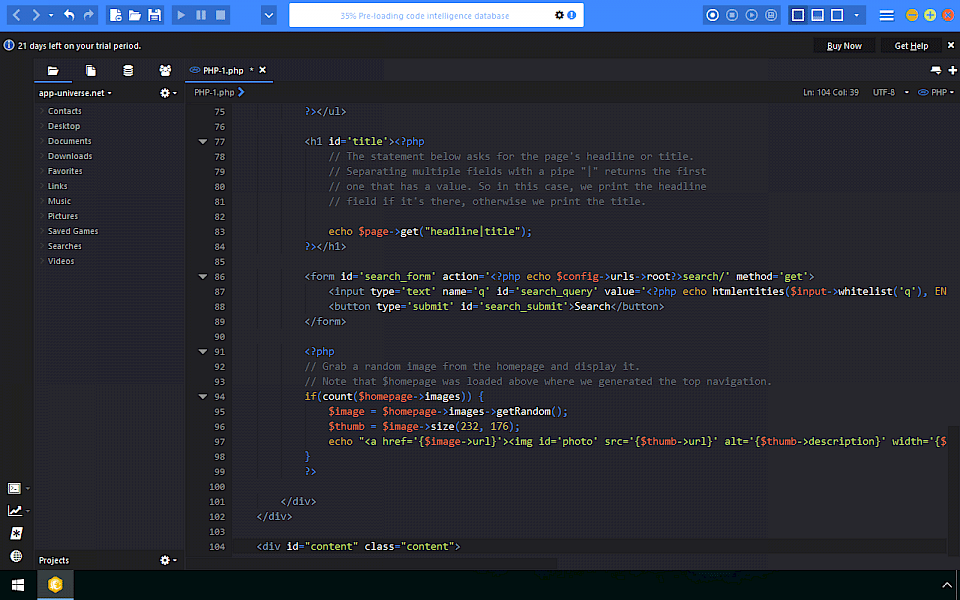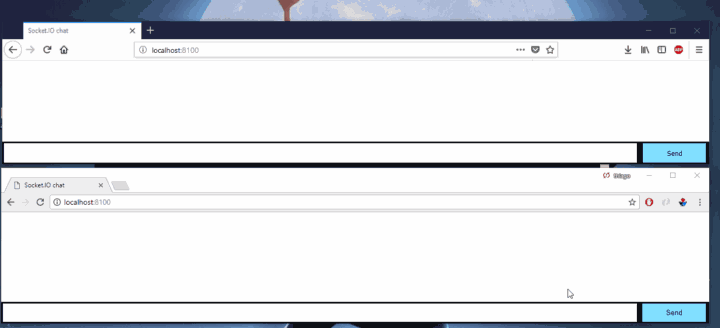Node.js provides a way to create "add-ons" via a C-based API called N-API, which can be used to produce loadable .node modules from source code written in C/C++. The modules can be directly loaded into memory and executed from within JS environment as simple CommonJS modules. The implementation of the N-API relies on internal C/C++ Node.js and V8 objects requiring users to import (#include) Node.js specific headers into their native source code. To address the issue, third parties have introduced open-sourced С/С++ wrappers on top of the API that partially alleviate the problem.
They simplify interfaces, but as a side effect they may also introduce complexity which maintainers have to deal with. Even though the core functionality of Node.js resides in a JavaScript built-in library, modules written in C++ can be used to enhance capabilities and to improve performance of applications. Npm comes preinstalled with Node.js, so any build scripts using npm run will work automatically. By default, if your site's base directory does not include a yarn.lock file , we will run npm install to install the dependencies listed in your package.json. You can override this behavior with the NETLIFY_USE_YARN variable described in the section on Yarn.
VS Code will automatically detect workspace versions of TypeScript that are installed under node_modules in the root of your workspace. You can also explicitly tell VS Code which version of TypeScript to use by configuring the typescript.tsdk in your user or workspace settings. The typescript.tsdk setting should point to a directory containing the TypeScript tsserver.js file. You can find the TypeScript installation location using npm list -g typescript.
If you use Yarn locally to install the JavaScript dependencies in your package.json, Yarn will create a yarn.lock file to record the module names and versions installed. If you commit this file to the site's base directory in your repository, we will install Yarn and run the yarn command to install the dependencies specified in your yarn.lock file. You can override this behavior with the NETLIFY_USE_YARN environment variable described below.
Note that, rather than copying the entire working directory, we are only copying the package.json file. This allows us to take advantage of cached Docker layers. Once we have our files inside the image, we can use the RUN command to execute the command npm install. This works exactly the same as if we were running npm install locally on our machine, but this time these Node modules will be installed into the node_modules directory inside our image. 2This args parameter makes the Node container accessible through port 3000.
Because a typical node_modules folder will contain thousands of files that change with every software update, you should exclude node_modules/ from your source control. If you ever start from a fresh clone, simply run npm install in the same folder your package.json is located to pull your required packages. Node.js is an open-source, cross-platform, back-end JavaScript runtime environment that runs on the V8 engine and executes JavaScript code outside a web browser. You will need to create a debugger configuration file launch.json for your Express application. Click on the Run icon in the Activity Bar and then the Configure gear icon at the top of the Run view to create a default launch.json file.
Select the Node.js environment by ensuring that the type property in configurations is set to "node". Install typeScript compiler globally npm install typescript -g Installed, you can view the version of the compiler on the command line tsc --version 2. This AST follows Babel's spec as closely as possible, for compatibility with tools that work with JavaScript source code. One practice often recommended by developers designing and implementing modern applications recommends that your code should fail fast. If an unexpected error occurs, do not try to handle it, rather let your program crash and have a supervisor restart it in a few seconds. The benefits of supervisor programs are not just limited to restarting crashed programs.
These tools allow you to restart the program on crash, as well as restart them when some files change. This makes developing Node.js programs a much more pleasant experience. To execute your tasks in the node image from Docker Hub, specify the image URL in the name field in the Cloud Build config file. Cloud Build starts the container specified in the namefield using the image's default entrypoint. To override the default entrypoint and define how the build step should be run when it is invoked, add anentrypoint field in your build step.
The node image in Docker Hub comes preinstalled with npm and yarn tools. Specify the tools in the entrypoint field to invoke them as the entrypoint of your build step. If you change your dependency requirements, the next build will re-run the installation command which may update cached dependencies if needed. It isn't guaranteed a change will take place if the previous dependencies still satisfy the installer, though! You can check which directories are cached by searching for $NETLIFY_CACHE_DIR in the run-build-functions.sh file for your site's selected build image.
If your build requires any JavaScript dependencies, you must list these in a package.json saved in the site's base directory in your repository. You can visit the npm docs to learn how to create a package.json file. You can install packages using the npm command npm install. If you pass the --save-dev parameter, npm will write the package as a dev dependency in the package.json file.
The --save-exact parameter instructs npm to save an exact version of a dependency, not a range of valid versions. The third thing that's going to happen once you run the npm install command is that a node_modules folder gets created. This is the folder where the actual source code of Three.js will be.
The included software list details default tool and language versions and whether they can be managed through environment variables, like HUGO_VERSION and YARN_VERSION. Available environment variables and recognized config files are noted next to the software name. You can choose the PHP version we use to build your site by setting a PHP_VERSION environment variable.
We recommend matching your local development environment's PHP version to a version that your selected build image supports. For a list of supported versions, refer to the included software list for your site's selected build image. If Platform.sh detects a package.json file in your repository, it automatically includes a default build flavor, that runs npm prune --userconfig .npmrc && npm install --userconfig .npmrc. If there is a package.json file present at the root of your repository, Platform.sh automatically installs the dependencies. We suggest including the platformsh-config package to facilitate access to the running environment.
Explanations about what this script does are covered in the test.sh file itself. This ultimately facilitates the maintenance of your Pipeline, especially if it gains more complexity. Because the file system is ephemeral you can't directly install services required by your application. Databases, queues, caching systems, storage, email services, etc. are considered "add-ons." Heroku web applications use backing services provided by Heroku or 3rd parties.
Once attached to your web application, the add-on services are accessed in your web application via environment variables. These are isolated, virtualized Unix containers that provide the environment required to run an application. The dynos are completely isolated and have an ephemeral file system (a short-lived file system that is cleaned and emptied each time the dyno restarts).
The one thing dynos share by default are the application configuration variables. Internally, Heroku uses a load balancer to distribute web traffic to all "web" dynos. Since nothing is shared between them, Heroku can scale an app horizontally by adding more dynos. You may also need to scale your database to accept additional connections. Usually the very first thing you do once you've downloaded a project written in Node.js is to install npm packages. This ensures that your application has all its dependencies installed into the node_modules directory where the Node runtime will be able to find them.
The @wordpress/scripts package handles the dependencies and default configuration for webpack and Babel. The scripts package expects the source file to compile to be found at src/index.js, and will save the compiled output to build/index.js. One way to fix this is to set a list of files that ESLint should ignore. In the root folder of the application, you can create a file called .eslintignore and add .eslintrc.js to it. Once we save this ESLint won't run any checks on the config file anymore. Most CLI applications accept one or more command line arguments, such as optional/required parameters, commands, flags/switches, or other configuration values.
Although you can parse command line parameters by inspecting the Node.js process.argv value, there are modules available that will save you a lot of time and effort. The yargs module is one such module for Node.js designed to support the most common CLI scenarios. If your build requires any Swift dependencies, you must list these in a Package.swift manifest file saved in the site's base directory in your repository. During the build, our buildbot runs the swift build command, using Swift Package Manager to install the dependencies and exact versions specified in Package.swift. For more information about managing dependencies with the manifest file, visit the Swift Package Manager documentation.
While npm install and yarn install have standard preinstall and postinstall scripts, you may want to run scripts only before or after other Heroku build steps. For instance, you may need to configure npm, git, or ssh before Heroku installs dependencies, or you may need to build production assets after dependencies are installed. If you are using npm, Heroku will use npm ci to set up the build environment. Npm-watch run scripts from package.json when there is any changes in your app folders or files. It's useful when you want to automate your build in server when there is any change. In order to execute your application Heroku needs to be configured to set up the appropriate environment for your application's dependencies and be told how to start.
For Node apps, all the information it needs is obtained from your package.json file. You can configure Amplify Hosting to use diff based backend builds using the AMPLIFY_DIFF_BACKEND environment variable. When you enable diff based backend builds, at the start of each build Amplify attempts to run a diff on the amplify folder in your repository. If Amplify doesn't find any differences, it skips the backend build step, and doesn't update your backend resources. If your project doesn't have an amplify folder in your repository, Amplify ignores the value of the AMPLIFY_DIFF_BACKEND environment variable.
To enable docker BuildKit by default, set daemon configuration in /etc/docker/daemon.json feature to true and restart the daemon. If the daemon.json file doesn't exist, create new file called daemon.json and then add the following to the file. The TypeScript compilation process can increase the bootstrapping time of an application.
However, you don't need to recompile the entire project whenever there's a change in its source code. You can set up ts- node- dev to significantly decrease the time it takes to restart your application when you make a change. Both of these things, the dependency section of your package.json file and the package-lock file, are things that you should never ever edit manually. For adding, removing, or updating packages you always use commands like npm install, npm uninstall, and so on.
This command initialized a package.json file in your root with some metadata. It has things like project name, description, version number, and so on. When you add the yes flag, all these values will have a default value.
WebMatrix is one of the best IDEs for NodeJS app development. The tool is accessible to only Windows developers and supports web development still it empowers developers to build robust web applications in an efficient and fast way using Node.js. Include any Rust dependencies in a Cargo.toml manifest file in the base directory in your repository. If you also commit a Cargo.lock, this will ensure that cargo installs the same exact versions of your Rust dependencies on Netlify's build image as it does locally. Instead cargo fetches them when cargo doc or cargo build executes as part of the build command.
Dependencies listed in composer.json are automatically installed with Composer, which is included in all build images. Node.js allows the creation of Web servers and networking tools using JavaScript and a collection of "modules" that handle various core functionalities. Modules are provided for file system I/O, networking (DNS, HTTP, TCP, TLS/SSL, or UDP), binary data , cryptography functions, data streams, and other core functions. Node.js's modules use an API designed to reduce the complexity of writing server applications.
This repository does not include a frontend application, but you can add one of your choice and access Strapi by defining it in a relationship in your frontend's .platform.app.yaml file. VS Code uses TypeScript type declaration files (for example node.d.ts) to provide metadata to VS Code about the JavaScript based frameworks you are consuming in your application. Type declaration files are written in TypeScript so they can express the data types of parameters and functions, allowing VS Code to provide a rich IntelliSense experience. Thanks to a feature called Automatic Type Acquisition, you do not have to worry about downloading these type declaration files, VS Code will install them automatically for you. At this point, we should test that our application runs.
The generated Express application has a package.json file which includes a start script to run node ./bin/www. Express is a very popular application framework for building and running Node.js applications. You can scaffold a new Express application using the Express Generator tool. The Express Generator is shipped as an npm module and installed by using the npm command-line tool npm.
Automatically restart the server - perfect for development is way too much hyperbole. Reloading server could mean logging into backend services which does take a long time in my case. "Perfect for development" would be something like hot-reloading classes while process is running in memory without losing state a-la what android studio does when you change source code. Developers interact with Heroku using a special client app/terminal, which is much like a Unix bash script. This allows you to upload code stored in a git repository, inspect the running processes, see logs, set configuration variables, and much more.
The REPL now properly formats stacktraces, and stays alive through asynchronous exceptions. Using --watch now prints timestamps as files are compiled. Fixed some accidentally-leaking variables within plucked closure-loops. Constructors now maintain their declaration location within a class body.
Chained class instantiation now works properly with splats. An error is thrown when the coffee command is run in an environment that doesn't support some ES2015 JavaScript features that the CoffeeScript compiler itself requires. This can happen if CoffeeScript is installed in Node older than version 6. The full-icu npm module can greatly simplify ICU data installation by detecting the ICU version of the running node executable and downloading the appropriate data file. After installing the module through npm i full-icu, the data file will be available at ./node_modules/full-icu. This path can be then passed either to NODE_ICU_DATA or --icu-data-dir as shown above to enable full Intl support.



























No comments:
Post a Comment
Note: Only a member of this blog may post a comment.